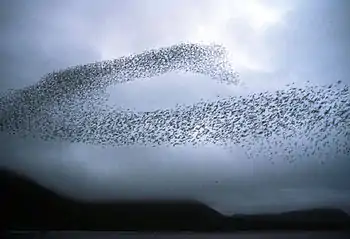Symmetry breaking of escaping ants
Symmetry breaking of escaping ants is a phenomenon that happens when ants are constrained into a cell with two equivalent exits, and perturbed with an insect repellent. Contrary to intuition, ants tend to use one door more than the other on average (i.e., there is a symmetry breaking in the escape behavior), so they crowd on one of the doors, which decreases the evacuation efficiency.
Description
The phenomenon arises in the experiments described as follows:
Environment
For the experiments to work, there is a given environment:
- Worker ants freshly collected from the field are enclosed into a circular cell with a glass cover in such a way that they can only move in two dimensions (i.e., ants cannot pass over each other).
- The cell has two exits located symmetrically relative to its center.
Experiment
In the first experiment, both exits are opened at the same time and let the ants escape. If the experiment is realized many times, in average, about the same number of ants use the left and right doors. In this experiment, the escape symmetry is not broken.
The second experiment involves a further step before opening the doors: an insect repellent fluid is poured into the cell at its center through a small hole in the glass cover. As a result, ants get very excited. If the experiment is realized many times, the number of ants escaping by one of the doors (which can be randomly either the left one or the right one) is significantly higher than the number of ants escaping by the other one, i.e., the escape symmetry is broken. The crowding of ants at one of the doors while the other one may be essentially free results in an inefficient evacuation in terms of time.
History
Inspired by earlier computer simulations that predicted a symmetry-breaking phenomenon when panicked humans escape from a room with two equivalent exits, E. Altshuler and coworkers from the University of Havana designed the experiment described in the section above, which revealed the symmetry-breaking effect in the leafcutting ant Atta insularis.[1]
The A. insularis ant (colloquially known as bibijagua in Cuba), like most social insects, displays a high degree of swarm intelligence, which has made them great survivors through millions of years of evolution. In Cuba, a person may be described as "smarter than bibijaguas" (sabe mas que las bibijaguas). The poor evacuation efficiency illustrated by the phenomenon of symmetry breaking in escaping ants is one of the few examples where bibijaguas do not seem to behave collectively in a smart way.
Geng Li and coworkers from Beijing Normal University tested whether and how the density of a group influenced symmetry breaking in escaping ants, using the red imported fire ant (Solenopsis invicta) to repeat the experiment mentioned above with different total of ants. The results show that the symmetry breaking increases at low density, but decreases after a peak. In other words, when density is low, the ant group produces a collective escaping behavior, while at high density, they behaves more like random particles.[2]
Explanations
The common idea is that the action of the repellent induces herd behavior in the ants. When ants are in "panic", they experience a strong tendency to follow each other. As a result, if a random fluctuation in the system produces a locally large amount of ants trying to reach one of the two doors, the fluctuation can be amplified because ants tend to follow the direction of the majority of individuals, leading to that door getting crowded.
E. Altshuler and coworkers were able to reproduce their symmetry breaking experiments in ants using a simplified version of the theoretical model proposed earlier by Helbing et al. for humans,[3] based on the fact that walkers tend to follow the general direction of motion of their neighbors ("Vicsek's rule"[4]), and such herd behavior increases as the so-called "panic parameter" increases. In the case of ants, the panic parameter is supposed to be low when no repellent is used, and high when the repellent is used.
A more "biologically sensible" model based on the deposition of an alarm pheromone by ants under stress also reproduces the symmetry breaking phenomenon, with the advantage that it also predicts the experimental output for different concentrations of ants in the cell.[2]
The pheromone mechanism shares the key element of the previous models: stressed ants tend to "follow the crowd".
Ants vs. humans escaping in panic
From the statistical point of view, human beings and ants seem to behave similarly in certain scenarios, such as evacuation from a room or cell under stress, resulting in symmetry-breaking phenomena; while ants increase their tendency to follow each other under stress, human beings seem to forget about emergency evacuation strategies, and just run towards the door to where most people run. However, the enormous physical and behavioural differences between humans and ants imply also big differences in their collective behavior.[5][6]
In the symmetry-breaking experiment on ants, for example, the individuals are relatively "polite"; ants are rarely crushed by others in the process of evacuation. When humans are in panic, however, deaths by overpressure or suffocation are common, as in the case of the Love Parade disaster in Germany in 2010, or the Astroworld Festival crowd crush in 2020.
References
- E. Altshuler; et al. (2005). "Symmetry breaking in escaping ants". American Naturalist. 166 (6): 643–649. doi:10.1086/498139. JSTOR 498139. PMID 16475081. S2CID 7250726.
- Li, G.; Huan, D.; Roehner, B.; Xu, Y. J.; Zeng, L.; Di, Z.; Han, Z. G. (2014). "Symmetry Breaking on Density in Escaping Ants: Experiments and Alarm Pheromone Model". PLOS ONE. 9 (12): 0114517. Bibcode:2014PLoSO...9k4517L. doi:10.1371/journal.pone.0114517. PMC 4281238. PMID 25551611.

- D. Helbing.; et al. (2000). "Simulating dynamical features of escape panic". Nature. 407 (6803): 487–90. arXiv:cond-mat/0009448. Bibcode:2000Natur.407..487H. doi:10.1038/35035023. PMID 11028994. S2CID 310346.
- T. Vicsek; et al. (1995). "A new type of phase transition in a system of self-driven particles". Phys. Rev. Lett. 75 (6): 1226–1229. arXiv:cond-mat/0611743. Bibcode:1995PhRvL..75.1226V. doi:10.1103/PhysRevLett.75.1226. PMID 10060237. S2CID 15918052.
- C. Detrain and J.-L. Deneubourg (2006). "Self-organized structures in a super-organism: do ants "behave" like molecules?". Physics of Life Reviews. 3 (3): 162–187. Bibcode:2006PhLRv...3..162D. doi:10.1016/j.plrev.2006.07.001.
- S. Boari; et al. (2014). "Efficient egress of escaping ants stressed with temperature". PLOS ONE. 8 (11): e81082. Bibcode:2013PLoSO...881082B. doi:10.1371/journal.pone.0081082. PMC 3843683. PMID 24312264.
